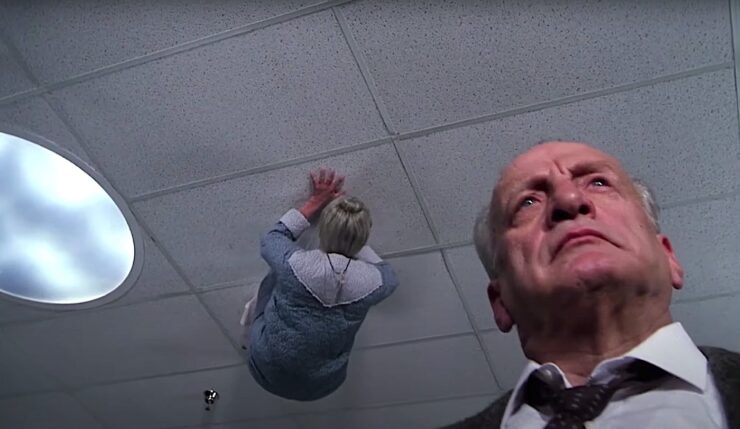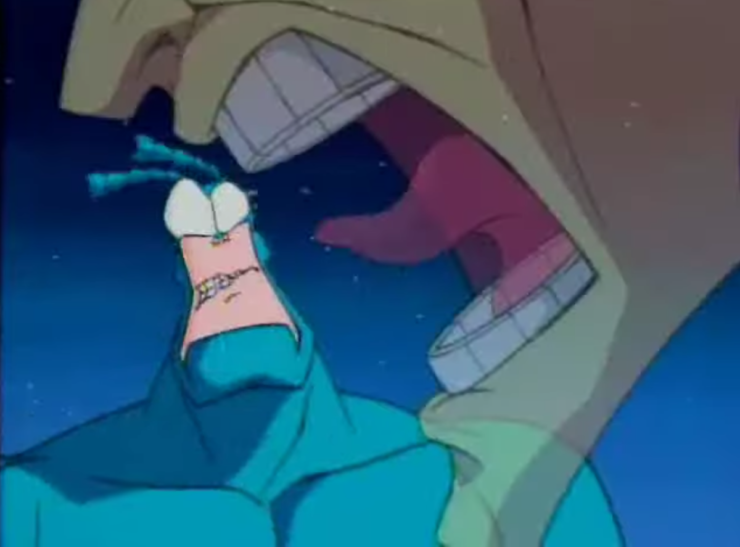Welcome to Close Reads! Leah Schnelbach and guest authors will dig into the tiny, weird moments of pop culture—from books to theme songs to viral internet hits—that have burrowed into our minds, found rent-stabilized apartments, started community gardens, and refused to be forced out by corporate interests. This time out, we take a trip to a rocky beach to talk about a haunting scene from Jonathan Glazer’s film adaptation of Under the Skin.
I’m not a brave person, but I am trying to get better at being brave on the page. What are things I don’t want to look at, but should? How can I get at truth in my fiction? How can I write criticism that people find useful?
When I was trying to think of artistic bravery, my mind washed up on the shores of Jonathan Glazer. Specifically, what I think of as “the beach scene” in Under the Skin.
Under the Skin is the rare example of me liking a movie better than the book—mostly because I think the movie is its own entity. The book (by Michel Faber) is quite good, a dark sociological look at humans and the environment (it actually reminds me, weirdly, of Mary Doria Russell’s The Sparrow) that spends most of its time in the mind of an alien hunting human prey.
But Glazer’s adaptation of the book is a miracle. The way he takes the book’s themes and runs into a direction that uses the strengths of film, color design, sound design, showing us a story rather than telling us a damn thing. When I watched it I felt like I was seeing something new.
And the beach scene to me is the best example of what it does well.
The scene opens with something innocuous, even nice. A dog is swimming in an inlet off Scottish coast. The unnamed alien, whom we’ve already seen prey on several men, watches a man swim a little further down the beach. In a cut back to the other end of the beach, we see a woman standing right at the shore, waving to a man and a baby, her back to the dog. Then the camera’s back with the alien, hanging a few feet behind her as the swimming man comes in and walks up the shore.
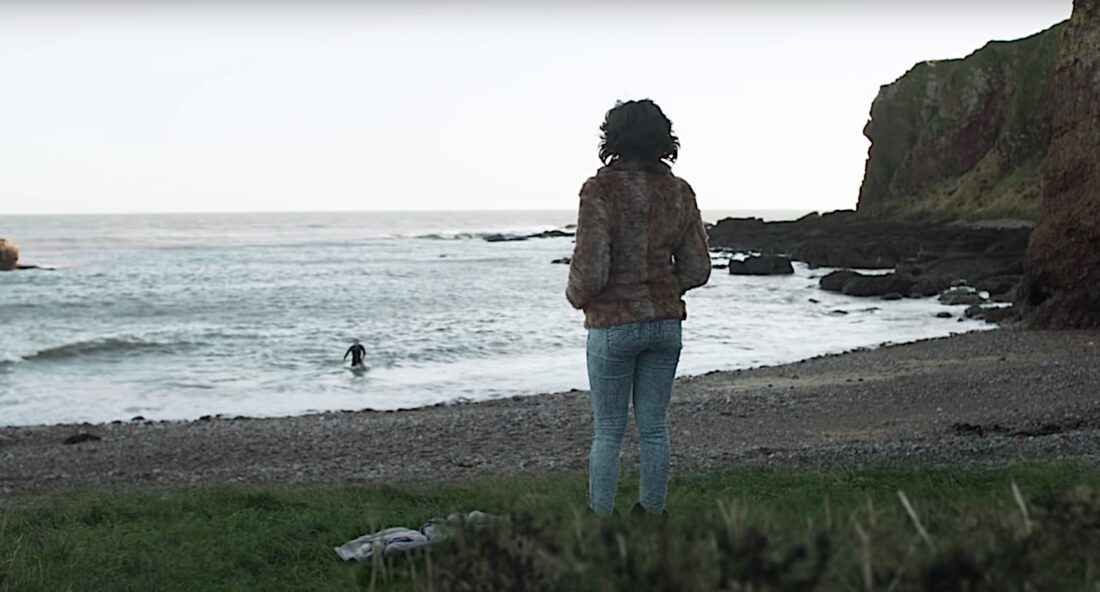
She begins what we know is her usual routine: asking him questions that will, potentially, get him to explain something to her—the aliens have figured out that it’s an easy way to get a man to open up—interspersed with questions that seem innocent and pleasant but are actually her way of learning if anyone will miss him if he disappears. He’s wary, but does tell her he’s travelling, alone, from the Czech Republic. As she’s about to press further, he looks past the alien and abruptly sprints off down the beach. The alien looks after him, her face reverting to the blankness she holds when she isn’t flirting for work.
The woman we saw before is swimming out past the breakers to save the dog, who’s been caught in a tide. She’s fully clothed, even leaving her heavy jacket on. The man (presumably her partner) leaves the baby to chase after her, and the Czech man dives in after both of them. The camera stays at its remove. We watch the dog go under, then the woman, as the man desperately takes on wave after wave. The Czech man gets to him after he goes under once and hauls him back to shore, but he’s no sooner let go than the man plunges in again. He goes under as the Czech man sprawls on the beach, too exhausted even to crawl out of reach of the waves.
The couple’s child sits alone on the rocks and screams.
The alien walks down the beach, inexorable. She lets waves break over her legs and boots and shows no sign of cold. She stands over the Czech man. Then she sorts through the stones for a moment until she finds one that fits easily in her fist, and bashes the Czech man in the back of his skull. Just once, just enough to knock him out. She drags him back toward her waiting van.
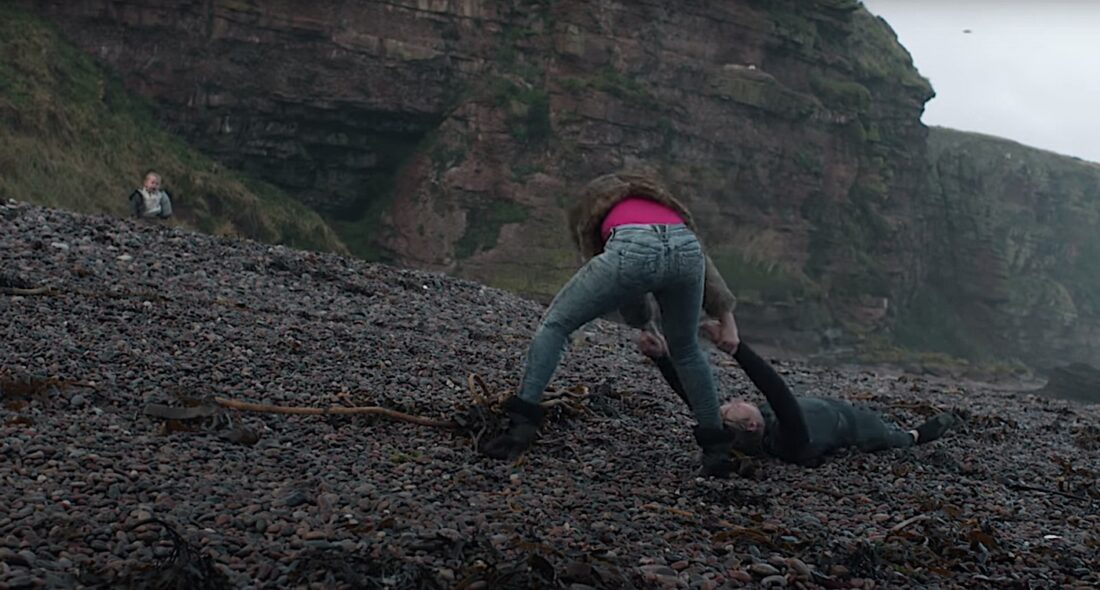
She never looks at the baby.
Just this could have been enough. Instead Glazer shows us the alien driving the man back to her house, the man still slumped over and unconscious in the passenger seat. He shows us the silent man, who appears to be the alien’s handler also in human disguise, back at the beach in the dark, gathering up the Czech man’s belongings so as to leave no trace of him. Again, this could have been enough. Instead, the camera follows the man down the beach as he retrieves the Czech’s towel.
The baby is still there. Still screaming. The man takes no notice of it and leaves the way he came. But the camera doesn’t follow him, instead it gives us one of the only closeups of the sequence, sitting squat in front of the baby, watching it sob, try to stand, fall back down. The camera is impassive. We know that no one knows it’s here. No one will hear it over the waves.
A few scenes later, we watch the alien as she hears a different child crying, in a car next to hers in traffic. In another scene, later still, she listens to a news bulletin that says the man’s body has been found on the shore, but that his wife and their child are still missing.
Did someone else take the child? Was it taken by the sea when the tide came further in? Is it still crawling down the beach alone? We don’t know. We never know.
Why did this come to me when I was rifling through moments of artistic bravery like stones on a beach? In some ways it’s the best moment in a very good movie, but it’s also doing something I hate. I hate child endangerment in fiction, and I hate animal deaths. They’re both cheap plays for emotion, easy screws to turn if you want your reader or audience to feel something.
So why does this work so well?
Part of it’s the camera placement. The camera neutrally records everything from a slight distance. It’s not a totally zoomed out God’s Eye shot that would elbow us in the ribs with the idea that some Unseen Other is watching tragedy unfold. It’s not fully the alien’s POV, because her actions are also recorded. It’s not zooming in on people faces. We’re never in the water with the dog or the people as they drown.
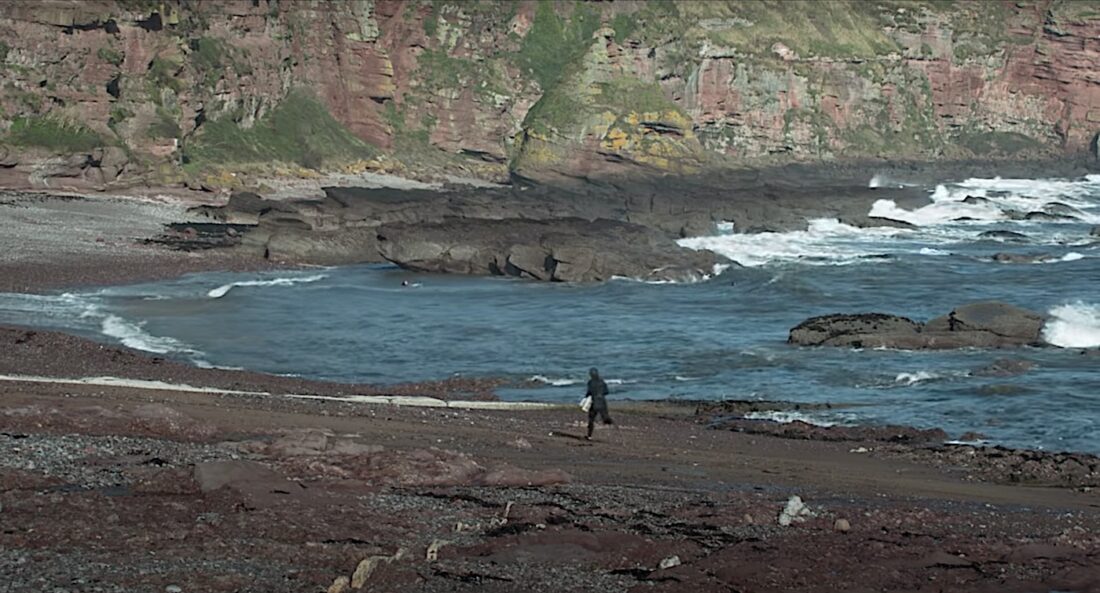
The humans act in recognizable, though slightly heroic ways, the woman going to rescue her dog with no thought for her own safety until it’s far too late, the husband diving in after her even though he can see how bad the tide is now. The Czech man going after both of them, despite already being worn out from a swim in these cold choppy waters. There too—the Czech charges after the family. He’s focused entirely on what he can do, which is get the husband, the closest one, the one who hasn’t been caught between tides or swept into a rock. The husband blindly going back in without even a backwards glance at the man who saved him, or the baby.
The camera doesn’t take on the alien’s point of view as she walks up the beach to the Czech man. It stays back and lets us see that she’s simply pursuing prey. She’s not angry—this is just part of the hunt. And then my favorite moment of all: the rock selection. As the baby sits a few feet away, crying, the alien matter-of-factly chooses a rock to hit the Czech man. She’s completely focused on finding a good rock. She’s not in a hurry, she’s not worried about being caught, or the man escaping.
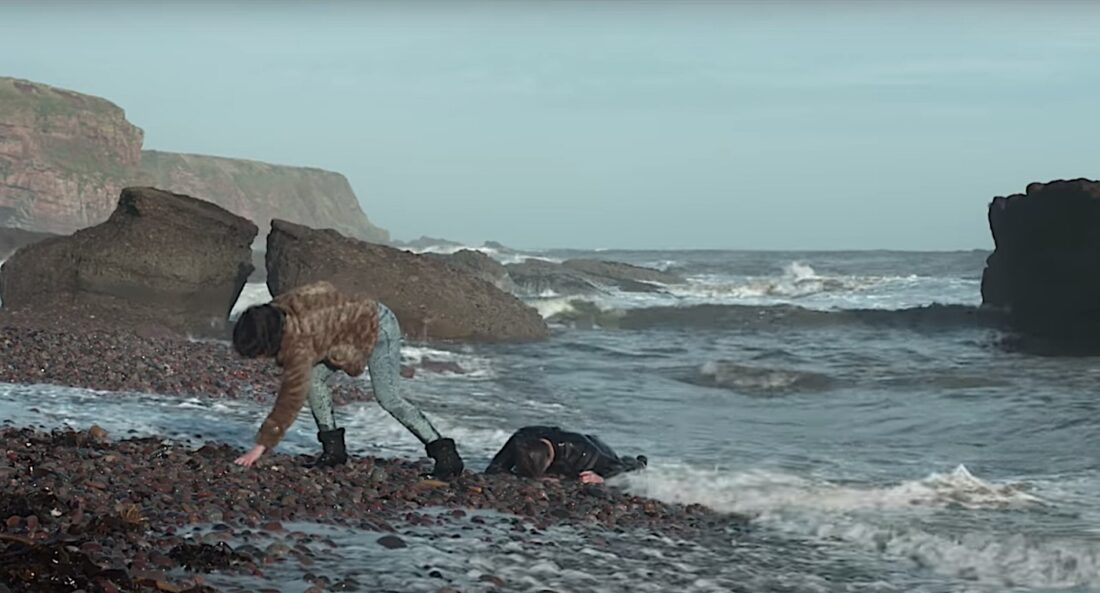
So many other ways it could go: the Czech man could yell to the alien for help. The wife could scream at the husband to go back to their child. The husband could look back at the kid instead of diving for his wife. He could take a swing at the Czech man rather than saving all of his panic and energy for the second attempt in the water. The husband could make the second attempt while the wife was still above water. The alien could use a rock to silence the child, annoyed by its screaming. She could hit the Czech inexpertly the first time, and have to hit him repeatedly to incapacitate him. She could reveal extreme strength (as happens in the novel) and be able to lift the man and carry him easily. The baby could try to walk to her, could hold its arms up to be lifted.
But none of that happens. Nothing is told, nothing is indicated, nothing is underlined or highlighted or italicized. No tip into melodrama or pathos or torture porn. There is only what we see: the tide flowing in and out. The man who abandons the child to go after the woman—twice. The other man who goes in after them, despite knowing what he’s getting into. Who saves the person closest to him, and then is too exhausted to see that his rescue has been undone. The baby screaming with no awareness of what’s happening, only that it’s alone suddenly. The alien watching all of them, waiting to see what happens, finishing her assignment with no fuss or extraneous violence.
A different movie might show us the alien going back for the baby, or calling the police about it. A different movie might show us an alien who listens thoughtfully to the broadcast. Instead there isn’t even the barest hint of emotion. Even when she hears the other baby crying in a later scene, her expression only hints at curiosity—not empathy or pity. The beach scene is only the first tiny step toward empathy with humanity as she watches a succession of people try to help each other and fail. There’s still another half hour to go before she frees one of her captives, and another ten minutes after that before she attempts human food. It isn’t that she hates us or fears us or that we disgust her—we are precisely as interesting as the ant she observes in the opening scene, the fly she watches later, the dog swimming out into the waves.
The water flows, the waves crash, the cliffs loom over the tragedy. Nature doesn’t care that these people and their dog are dying. It doesn’t care about the terrified baby. It doesn’t care that an alien has come to Earth and is standing by and watching it all. Nature is implacable, unreasonable, unswayable. The sun goes on shining, the water goes on flowing.
Glazer keeps his camera back and observes. He neither holds our hands (the camera is going to sit right there and watch the baby cry, and there’s nothing we can do about that except close our eyes and stick our fingers in our ears), nor pats our heads (the radio bulletin doesn’t give us the happy news that the baby was saved, at least). By staying impassive and allowing cause and effect to play out, he creates a gap between us and the movie. We can fill that gap with emotions, empathy, sorrow, anger, a sense of futility—or we can balk and reject the film. It’s an act of artistic bravery to trust the audience to pay attention and come all the way to him, rather than meeting us halfway.












